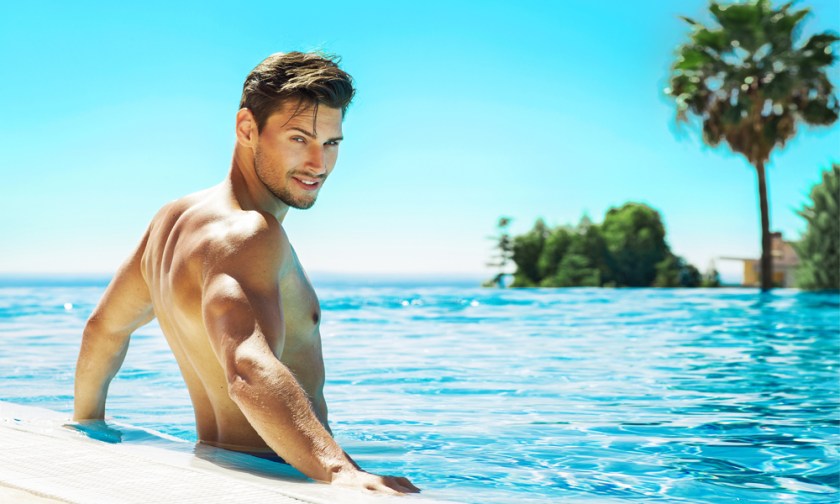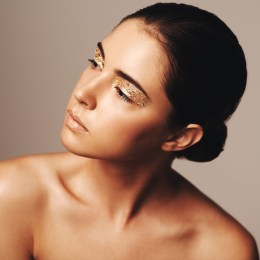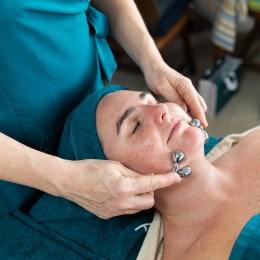If you’re looking for new ways to expand your client base and profits heading into 2018, the answer is clear – attract more men.
The male “appearance” market is growing rapidly, according to latest statistics from the International Spa Association (ISPA), which has been tracking the rise of the male spa industry for over a decade.
Its findings show that in 2005 only 29% of spa-goers were male. Now, thanks to changing attitudes towards male grooming, that figure has risen to 49%.
The change can only be recent, as in 2013 an ISPA survey found the following reasons as to why men don’t go to spas:
- 11% said it’s “too indulgent”
- 14% said because “none of my friends go”
- 17% said they were embarrassed to go
- 19% said “spas are for women”
CREATING MAN CAVE NIRVANAS
However, it seems that a growing number of men are realising that spas aren’t solely for women, with men-only spas cropping up all over the world.
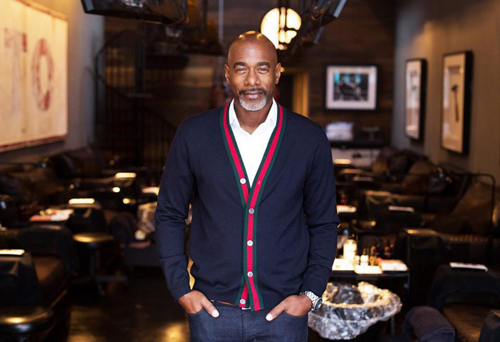
For instance, Michael Elliot made a name for himself writing screenplays for Hollywood movies such as Brown Sugar and Just Wright.
But as he approached his 50th birthday, he worried that he’d never built anything real and started to think about starting a business.
Walking into a nail salon in Santa Monica, California, for a pedicure one day, Michael said he “felt everyone staring at me.”
It made him realise what he wanted to do: create a place where men could get manicures and pedicures without feeling uncomfortable.
He opened his first Hammer & Nails location in Los Angeles in 2013 – that he calls a “man cave nirvana” – and was soon invited on to US TV’s Shark Tank.
Michael hoped to get a $200,000 investment for a 20% stake (valuing the nascent company at $1 million), and was rejected by the Sharks.
Instead, after the show aired, he raised the amount he needed from eager viewers, and began to set up the infrastructure to franchise the business.
Men’s spas are taking the emphasis away from the more female-oriented idea of pampering and putting the attention instead on “health and wellness” with sports massage and pedicures the more popular choices.
But of course if you already have a salon, spa or clinic with an existing, predominantly female clientele and don’t want to change your business model, how do you attract more men?
CREATING THE VIBE
Brisbane cosmetic physician Dr Mary Dingley, speaking on behalf of the Australasian College of Cosmetic Surgery, says her clinic has a 30-40 percent male patient base, which is increasing.
“We treat all ages – from children to the elderly – as we cater for birthmarks, acne and acne scarring through to facial vein treatment and solar damage treatment, as well as hair and tattoo removal,” Dr Dingley says.
“Those with more `cosmetic concerns’ would tend to be in the young adult to middle age bracket.
“Men tend to want information about efficacy of treatments, cost and downtime. They generally don’t want the `relax and spend time’ message.
“Anything to do with pampering tends to put them off – for instance, candles, mood lighting, relaxation music and ‘girly’ decor (as are many women).
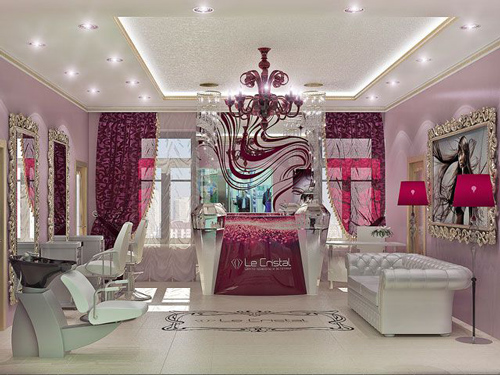
“Men usually prefer a more business-like setting where it’s very clear that they sit in a waiting room, will be seen on time by an efficient and knowledgeable professional, will be advised on what can and can’t be done and arrangements are then made if things can’t be easily done then and there. Magazines that are geared towards men are also appreciated.
“Most men also have a specific concern in mind when they come for a consultation. They often don’t like to admit it but usually cope less well with painful procedures.
“Pain management is therefore appreciated but may not be brought up by the patient.”
Dermatologist Dr Adam Sheridan, of Specialist Dermatology Surgery and Laser in Melbourne and Adelaide (also a spokesperson for the Australasian Academy of Facial Plastic Surgery), says his practice sees 40-50 percent males for cosmetic treatments overall, across all age groups, as they men become increasingly aware of options to improve and maintain their appearance.
“No offence to anyone, but males tend to request highly qualified doctors and registered nurses – they don’t tend to want treatment by very young-appearing staff members,” he says. “They also like to receive information from male sources.”
UNDERSTANDING MOTIVATION
“Due to their lacklustre preventative health care and sun-protective behaviour, men age poorly when compared with women,” says US dermatologist Dr Terrence Keaney, associate dermatologist at the Washington Institute of Dermatologic Laser Surgery and co-founder of W for Men, the first cosmetic and laser dermatology practice for men in the US.
“They have more severe wrinkles except in the perioral [eye] area. Men also develop wrinkles at an earlier age. Since men have less subcutaneous fat at all ages, they develop more folds and deep wrinkles with prominent volume loss.
“Despite their accelerated facial ageing, not all men are as concerned with the ageing process as women.
“They display a different set of motivations, concerns and aesthetic ideals compared with women. Men do not seek perfection, but want to maintain a youthful appearance.”
Dr Dingley says that in her practice men will usually present with a specific concern.
“They want to get rid of a specific thing – be it unwanted hair, a tattoo or veins on the nose,” she says.
“If a ‘because’ is mentioned it may be because they want to create a different perception or feel that the perception they currently create is erroneous.
“Examples include: `I want to get rid of this tattoo because people think I’m a certain type of person that I’m not’ or `I don’t want my kids to read these rude words because they’re just starting to learn to read’; `At work everyone thinks I’m unapproachable because I can’t stop frowning’; `I hate these veins on my nose because it makes people think I’m an alcoholic’.”
MIND YOUR LANGUAGE

In terms of visual language, simplistic marketing rarely works, according to Dr Sheridan.
“Manly images such as of cars and sport with a nice lady to the side might sound good but they won’t appeal at an individual level,” he says. “Appreciate cultural differences too.
“When consulting with male patients, the semantics should be very different from those employed with females – just as you don’t speak in the same way to female friends as you do your male ones.”
MARKETING MINDFULNESS
Top tips from Dr Terrence Keaney:
- Converting the fathers, sons, brothers and boyfriends of your female patients is the most effective marketing strategy, we have found.
- Promoting male treatments within your practice needs to be all-encompassing: every aspect of your internal marketing should also cater to men. Re-examine your website, brochures, videos and signage to ensure that it is clear your practice also caters to men.
- Ensure your staff is comfortable talking about male treatments with your female patients.
- External marketing should focus on social media with your activity tailored to each gender. With social media, you can connect with male patients and followers outside of the office. You can build your online image, adding to your reputation and developing a presence that will help attract reluctant male patients.
- Social media posts targeting men should be more educational and informative. Do not forget to use social media outlets that are more frequently utilised by men, such as LinkedIn.
- Marketing to men is only one part of attracting men to your practice. You have to create an environment where men feel comfortable. If you are serious about attracting men, carving out a male clinic space or waiting room is ideal. The importance of creating a practice environment that is not intimidating to men is crucial.
- Men really want it to be about them. In my practice, the male clinic is located in a connected – but separate – suite of rooms. Having their own clinic space allows us to tailor our internal marketing to them. The male clinic waiting room is stocked with male magazines and displays a video feed of sporting events and financial news.
- While men generally like seeing female staff, the medical staff should also include at least one male medical assistant. Men may feel more comfortable talking about cosmetic concerns with another man. Reassurance from another man can help reluctant male patients, in particular.
- Mass media marketing of aesthetic treatments tends to target women. As a result, men are less cosmetically savvy. They lack basic understanding of available cosmetic procedures. Male patients are often unaware that there are procedures that can address their ageing concerns.
- Because men are less informed about the range of available procedures, they need to be more thoroughly educated about the various options with a full discussion of their individual risks and benefits.
- They also do not like surprises, so it is important to clearly define the side effects and downtime with any procedure.
LIQUID GOLD
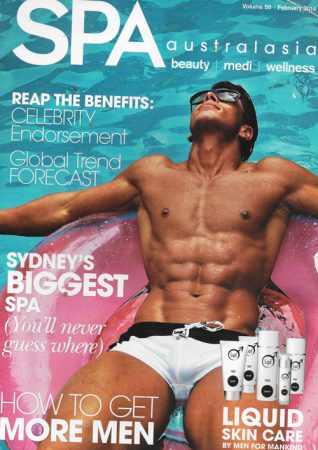
Skincare ranges designed specifically for men are also growing apace.
In our February 2014 issue (when we were Spa Australasia; we rebranded as SPA+CLINIC in July that year), on the cover was Chris Glebatsas, co-founder of then-fledgling professional and retail brand Liquid Skincare (Lqd).
He and his life and business partner Anthony McDonough were in Hong Kong to launch their “baby”(born in 2012) on the international scene for the first time at Cosmoprof Asia in late 2013.
In the intervening years Lqd has kicked major goals. The Melbourne-based couple struck up a partnership with SG Cosmetics in 2015, one of the largest cosmetic distributors in Asia after attracting huge interest at Cosmoprof.
Asia Pacific accounts for nearly 60% of worldwide sales in the segment, a fast-growing division of the USD $33 billion male grooming industry.
“But our decision [to partner with SG Comsetics] was not based purely on shifting volume,” says Anthony. “We needed a distributor we could trust to represent our brand and to retain our premium positioning in the retail market.”
The partnership quickly paid dividends with Luxola, the largest online skin care and cosmetics retailer in South-East Asia, selling Lqd’s complete line.
The range is now being stocked in Harrods, London, David Jones in Sydney and Sephora and Bloomingdale’s in the US.
“Our intention has always been to expand Lqd internationally, so our products have been developed to suit the skin care requirements of men around the globe,” Anthony says. ”However, Australia remains a priority market.”
Since its launch in 2012, the business has achieved more than 50 percent year-on-year growth and currently brings in $5 million annually.
Chris Glebatsas recently told The Australian Financial Review: “People are over the gimmicky ingredients and big claims in skincare.”

